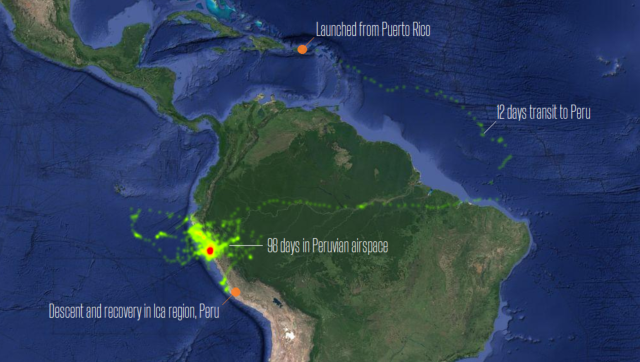
One of Puerto Ricans' most basic needs in the wake of Hurricane Maria is communication with the outside world. Cell phone companies on the island are still working to repair infrastructure after the hurricane took 95 percent of the island's cell phone towers out of service.
So X, Alphabet's company devoted to technological "moonshots," is sending a fleet of balloons to serve as cell phone towers in the sky. "We are now collaborating with AT&T to deliver emergency Internet service to the hardest hit parts of the island," writes Alastair Westgarth, who leads the company's balloon-based Internet efforts.
The idea of providing Internet service via balloons sounds crazy—indeed it has sounded crazy since Google first announced the effort, dubbed Project Loon, in 2013. But Google—now X—is deadly serious about making balloon-powered Internet access a real thing.
Westgarth acknowledges that “Project Loon is still an experimental technology and we’re not quite sure how well it will work.” But the company has been making steady progress over the last four years. The company can keep its balloons in the air for more than three months at a time, powered by solar energy. It has figured out how to efficiently steer flocks of balloons to keep them over an area that needs service.
How Project Loon works
Fundamentally, the balloons are a way to extend the range of an existing cellular network. A terrestrial cell phone tower communicates with a balloon soaring as much as 20 kilometers overhead. At that height, a balloon has a clear line of sight to a large area of the ground below. A single balloon can serve an area the size of Rhode Island. Phones on the ground communicate with the balloon the same way they would communicate with any other cell phone tower. X says that one balloon can serve thousands of customers simultaneously.
There's a big, obvious challenge, of course: wind. If you send a balloon up 20 kilometers in the air, it will quickly blow away from the desired coverage zone. Past balloon-based transmission schemes have tethered balloons with a cable, but that limits how high the balloons can go, and it increases the cost and complexity of the system.
At high altitudes, the winds mostly move in one direction, so the company's original plan was to just release a steady stream of balloons and have them slowly float around the world. As one balloon floated out of range for any given customer, there would be another one behind it. With enough balloons, people at certain latitudes would be within range of at least one balloon at all times.
But as X experimented with its balloons, the company realized that it could actually use wind to steer them north, south, east, and west. The balloons have on-board pumps that allow them to move up and down.
“From our millions of kilometers of test flights, we’ve been able to develop sophisticated models that allow us to more accurately predict the wind patterns at different altitudes,” a Project Loon post said in 2016. “Using this data, our software algorithms are able to determine which altitude has a wind pattern that gives us the best chance of keeping our balloons close to the areas where we want them.”
“We figured out how to cluster balloons in teams, dancing in small loops on the stratospheric winds, over a particular region,” wrote X CEO Astro Teller.
In one 2016 test, a balloon took 12 days to travel from Puerto Rico to Peru and then spent 14 weeks hovering in Peruvian airspace.

The technique wasn't perfect; the balloon would occasionally get blown out over the Pacific Ocean before being steered back over Peru.
The Peruvian experiment proved useful earlier this year when the country suffered from serious flooding. Because X had already done work in the country, X was able to quickly get its balloons aloft and provide connectivity to thousands of Peruvians who had been cut off from conventional communications infrastructure.
The company has developed other technologies to make this whole system practical. For example, an early challenge was that balloons would get blown away before they had been fully prepped for release. The team designed a balloon launchpad, depicted at the top of this article. The launchpad rotates so its open side is always pointed downwind, shielding the balloon from direct wind as it's prepared for release.
Bringing balloon Internet to Puerto Rico
X has solved a number of thorny technical problems for getting balloon Internet technology working. But using that technology to quickly provide service to ordinary Puerto Ricans was still a big challenge.
First and foremost, X needed on-the-ground partners. Project Loon's technology is fundamentally a way to extend the range of an existing cellular network, so X needed to partner with an existing Puerto Rican cellular provider. That local provider needed to modify some of its towers to communicate with the Project Loon balloons and correctly route customer traffic that came back from them. AT&T agreed to partner with X on the project.
X also needed approval from the Federal Communications Commission to operate in the area, which it got earlier this month. X says it also worked with the Federal Aviation Administration—presumably to get the rights to operate in the airspace above Puerto Rico.
"Project Loon is now supporting basic communication and Internet activities like sending text messages and accessing information online for some people with LTE enabled phones," Loon reported in a Friday blog post.
Puerto Rico is about three times as large as Rhode Island, so (in principle) you should be able to cover most of the island with three balloons. In practice, of course, X needs more than that since steering the balloons with air currents is far from an exact science. At any given time, some balloons will be drifting off-course or working to get back on-course. More balloons will be needed to provide reasonable levels of reliability.
reader comments
85